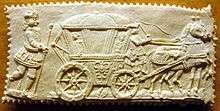Springerle

Springerle is a type of German biscuit with an embossed design made by pressing a mold onto rolled dough and allowing the impression to dry before baking. This preserves the detail of the surface pattern. They are most commonly seen during the Christmas season.
The name springerle means "little jumper" or "little knight". Their origin can be traced back to at least the 14th century in southwestern Germany and surrounding areas, mostly in Swabia.[1]
Baking process
-

Raw springerle dough, just out of the wooden wedding-carriage mold (shown below).
-

Springerle dough after drying for a day.
-

Baked springerle, showing typical "foot".
The major ingredients of Springerle are eggs, white (wheat) flour, and very fine or powdered sugar. The biscuits are traditionally anise-flavored, although the anise is not usually mixed into the dough; instead it is dusted onto the baking sheets so that the biscuit sits on top of the crushed anise seeds.
Traditional Springerle recipes use hartshorn salt (ammonium carbonate, or baker's ammonia) as a leavening agent. Since hartshorn salt can be difficult to find, many modern recipes use baking powder as the leavening agent. Springerle made with hartshorn salt are lighter and softer than those made with baking powder. The hartshorn salt also imparts a crisper design and longer shelf-life to the Springerle. To make Springerle, very cold, stiff dough is rolled thin and pressed into a mold, or impressed by a specialized, carved rolling pin. The dough is unmolded and then left to dry for about 24 hours before being baked at a low temperature on greased, anise-dusted baking sheets.
The leavening causes the biscuit to at least double in height during baking. This "pop-up" effect may be the source of the name in German, and produces the characteristic "foot" along the edges, below the molded surface.
The baked biscuits are hard, and are packed away to ripen for two or three weeks. During this time, they become tender.
Another method of making Springerle is to not chill the dough at all. Commonly, after mixing all the ingredients together, one would cover a surface with flour, and use a regular rolling pin (also covered in flour) to roll out the dough to about half-an-inch of thickness. Flour would be spread over the top surface of the rolled-out dough, and also on the specialized Springerle rolling pin. One would whack the Springerle rolling pin against one's hand a few times, to dislodge any flour caked into the designs on it, and then proceed to carefully but firmly roll out the molds. One uses a knife to cut out the small, rectangular cookies (often 2x1 inches), and place them on a wooden board to dry overnight (or for at least twelve hours). As this process is repeated, the dough gets more brittle due to the added flour and doesn't hold the molds as well. Therefore, it is important to roll the dough out in small batches (instead of all at once), to keep the moisture in so the cookies hold together. Anise seed is sprinkled on the baking sheets just before putting them in the oven (about ten minutes is usually sufficient, but the cooking time also depends on thickness). 1-2 teaspoons of anise extract can also be added to the dough to increase the taste (which is rather like licorice), and the amount of cookies varies on the thickness. The usual recipe with 4 eggs and 3-4 cups of flour can yield anywhere from 60-144 cookies, depending on thickness and the experience of the maker.
Molds
Molds are traditionally carved from wood, although plastic and pottery molds are also available. Pear wood is prized for its density and durability. Older handmade molds are folk art and are typically unsigned and undated.
The stamping technique may be derived from the molds used in some Christian traditions to mark sacramental bread, and the earliest molds featured religious motifs, including scenes from Bible stories and Christian symbols. Later, in the 17th and 18th century, heraldic themes of knights and fashionably dressed ladies became popular. Themes of happiness, love, weddings, and fertility remained popular through the 19th century.[2]
-

Springerle mold from the Landesmuseum Württemberg
-

This mold shows a wedding carriage and many figures.
-

The back side of the same mold, showing more figures.
See also
References
- ↑ Anikó, Samu-Kuschatka. "History of Springerle". http://andallthekingsmen.bizhosting.com/history.html. And All The King's Men. Retrieved 18 October 2014. External link in
|website=(help) - ↑ "Springerle History". http://www.sweetoothdesign.com/#!cookie-springerle/chyp. Sweet Tooth Design. Retrieved 19 October 2014. External link in
|website=(help)
External links
| Wikibooks Cookbook has a recipe/module on |